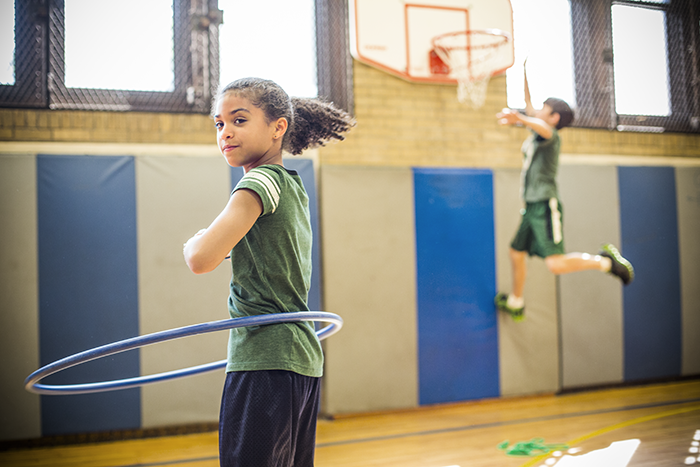How We Can Work to Prioritize Physical Education in Our Nation’s Schools
by Charlene Burgeson, Executive Director of Active Schools
Millions of students are gearing up to start the new school year. They’re excited to see their friends, meet their new teachers and get back to their favorite activities.
Many kids, however, won’t get enough of one of the biggest necessities for their overall development: physical activity. Whether it takes place in the gymnasium, on the playground or in the classroom, physical activity plays a vital role in a child’s physical, social, emotional and academic development.
There are a variety of effective ways for kids to be physically active at school, but the most important is physical education class because it serves as the foundation for skill development.
Not adequately prioritizing physical education in the school schedule is short-sighted. Here’s what Action for Healthy Kids and Active Schools know about the impact of prioritizing physical learning and what we can do together to create brighter futures for our children.

The problem with not adequately prioritizing physical education
The Institute of Medicine of the National Academies recommends that schools should provide access to at least 60 minutes per day of vigorous or moderate-intensity physical activity, more than half of which should be accomplished during regular school hours.
So why are only 24 percent of kids in the U.S. getting this hour of physical activity at least five days per week?
Across the country, schools are facing time and budget challenges, and many are laser-focused on test scores at the expense of providing a well-rounded education. But as we know, test scores are not the only measurement of a child’s success and well-being – and in fact can be a cause of mental health issues that are becoming all too common among youth in our society.
We expect a lot from our schools. They’re responsible for making sure our kids are challenged academically, supported emotionally and engaged physically in a safe, nurturing environment. We also know from our personal lives that while time and budget constraints are very real, we make time for the things that are most important to us – and schools can do the same.
Physical education class is where students develop the knowledge, skills and confidence to participate in and enjoy many different forms of movement. It is where teaching and learning take place so that kids can practice what they’ve learned in physical education both inside and outside of school. Physical activity is about the closest thing that exists to a magic bullet for good health and well-being – so why wouldn’t we take full advantage of it for our kids and ourselves when the benefits include:
- Helping kids and teens improve cardiorespiratory fitness; build strong bones and muscles; control weight; reduce symptoms of anxiety and depression and reduce the risk of developing health conditions such as heart disease, cancer, type 2 diabetes, high blood pressure, and obesity.
- Teaching a spectrum of “soft” skills, including trust, patience, sportsmanship, respect, cooperation and leadership.
- Increasing blood flow that stimulates the brain and boosts mental performance, helping students with concentration and engagement in the classroom.
The benefits are clear, but schools are not doing enough to prioritize and provide physical education and other physical activity opportunities before, during and after school. The good news is that if we take action together, our kids will receive the physical education they need to thrive.
The opportunity to help schools prioritize physical education
It’s our collective responsibility to help schools prioritize physical education. A well-balanced education that includes physical, social, emotional and academic learning is critical for children to reach their full potential. Parents, educators and businesses all have an essential role to play. Here are a few ways you can help:
- Parents: You can make an impact by signing up for Take Your Parent to PE Week, a fun, immersive program in late September that introduces parents to the PE program and teachers at their child’s school. With 85 percent of parents believing it’s important that their child’s school is an active school, we need your help demanding that your child’s principal create a school schedule that includes physical education, recess and other physical activity opportunities, and that the school board adequately funds it in the district budget. You can also volunteer, facilitate community partnerships and donate to physical education programs at schools.
- Educators: Use Action for Healthy Kids’ online engagement program, Game On, which walks schools through six key steps for building a healthier learning environment and includes hundreds of healthy activities such as open gym, walking trails and school Olympics. You can also download Active Schools’ Guide to Engaging Parents in School Physical Education and Physical Activity. Similar to parents, educators can advocate for physical education schedules and push for funding in the district budget.
- Businesses and organizations: You can join the Active Schools movement, a collective impact initiative that brings together health-and-activity-focused organizations from Fortune 500 companies to small nonprofits. Together with these partners, Active Schools and Action for Healthy Kids gives schools access to programs, trainings and grants to help enrich physical education and classroom curricula, as well as other before-and after-school programs.
It’s time to take action together to make school a place where every kid gets 60 minutes a day to run, jump, skip or leap into a brighter future. If we can achieve this, children across the country will start the new school year healthier, happier and hopeful for what’s to come.
Categories: Making Change Happen, Physical Activity, PE, & Play